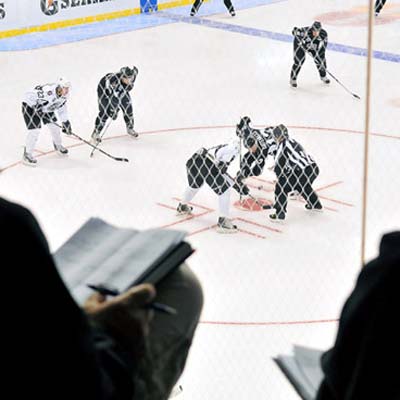We’re coming up on the trade deadline for the NHL. Lots of names are going to be floated and some players will be traded. Raphael Diaz and Dale Weise were traded today as I was finalizing this post. According to THoR (all events) Diaz is a player who has been worth 2 or 3 wins per year over a replacement defensemen but will he be worth roughly that for Vancouver? Certainly the Canucks hope so. In that vein, I recently got a question about what would happen to the THoR value for a player that switched teams. This was in response to some recent work on evaluating the performance of THoR as a two-way player metric. This is a reasonable question and so I’m going to investigate it here. At the same time there has been some twitter banter about Corsi or CorsiRel being a ‘team metric’ rather than a player metric. This is roughly the same question that is being asked of THoR: how well does the metric isolate individual player talent? As we’ll see below, CorsiRel is only slightly impacted while THoR is impacted almost not at all.
Certainly a player’s Corsi or Corsi For % can be a reflection of their team and their teammates (see Rob Scuderi with LA or Dennis Seidenberg with Boston). However, the point of CorsiRel is to differentiate between how the team does when the player is on and off the ice. This is a form of without and with you or WOWY as it is commonly known.
In the case of THoR, we have explicit terms in our model to account for the other players on the ice with a given player as well as rink effect. Thus, we have a stronger form of WOWY built in that simultaneously is adjusting for the impact of other players on the ice for both teams during a given event. THoR also accounts for a variety of other factors including score effects, home ice, zone starts, etc. Details can be found here.
To investigate this particular question, I’m going to look at how year to year correlations change for players who are on the same team both years compared to players on different teams for both years. If the correlation or the ability to predict how a player does in the future is substantially decreased by changing teams, then that metric is not isolating individual player talent. Thus, our cohort of players will be those that finished consecutive seasons with different teams but finished the preceding or subsequent season with the same team. We won’t limit ourselves to players that spent an entire season with a different club since that would drive down some already smaller sample sizes.
In statistical data collection, there is an idea that an individual/subject is there own best control. This comes into play when testing, for example, a drug vs a placebo. No matter how well you set up your study there is always a worry that the groups were different at the start, in which case conclusions at the end are suspect. To deal with that here I’m going to look at the same group of individuals over multiple years when they have switched teams and when they have not. The drawback to this sort of analysis is that there could be changes in the players themselves from year to year. This will be particularly acute for players at the end of their careers when their abilities are likely declining (Steve Sullivan, Jerome Iginla, Jaromir Jagr).
THoR
For the data here I am using the latest version of THoR (all events) and taking players with a minimum of 2000 plays in each seasons considered. Here, in total, we used the following seasons: 0910, 1011, 1112, and 1213. (Unfortunately, we don’t have THoR further back than the 0910 season.) Each row of the table represents a cohort of players. The first row, for example, deals with players who finished the season with the same team in 0910 and 1011 but finished 1112 on a different team. Vice versa for the 56 players involved in the results for the second row. Our sample sizes here are not large so a decent amount of variation between the correlations will be expected. It is unexpected that we would see a higher correlations for players when they change teams. Certainly some of those differences are less than 0.01 so it is safe to say that they are likely just noise; however, they do also mean that there is very little change in the performance of THoR when players change teams. On average here that difference is less than half of one percent. Adding a standard error to that you get about 4% as a reasonable amount of drop in correlation due to players changing teams.
| Seasons with same team | Seasons with different teams | Sample size | Correlation across seasons with same team | Correlation across seasons with different teams |
| 0910/1011 | 1011/1112 | 61 | 0.816 | 0.726 |
| 1011/1112 | 0910/1011 | 56 | 0.821 | 0.833 |
| 1011/1112 | 1112/1213 | 36 | 0.852 | 0.856 |
| 1112/1213 | 1011/1112 | 31 | 0.732 | 0.786 |
CorsiRel
We next turn to results for CorsiRel. The players here had to have at least 30 games played in each of the three seasons considered. We did the same analysis as we did for THoR using data from CorsiRel (downloaded from behindthenet.ca). Originally, we had the same years involved for CorsiRel as we did for THoR. However, those results were highly variable and so I added some additional years to give a bigger picture of what was going one. I pulled the CorsiRel for the 0708 and 0809 seasons with the same criteria for . The average change in correlations by cohort is 10% with about an 8% standard error. Adding and subtracting one standard error to that mean it’s reasonable to say that the impact of changing teams is a difference of between 0 and 18%.
| Seasons with same team | Seasons with different teams | Sample size | Correlation across seasons with same team | Correlation across seasons with different teams |
| 0708/0809 | 0809/0910 | 85 | 0.686 | 0.647 |
| 0809/0910 | 0708/0809 | 70 | 0.577 | 0.529 |
| 0809/0910 | 0910/1011 | 81 | 0.569 | 0.422 |
| 0910/1011 | 0809/0910 | 72 | 0.668 | 0.639 |
| 0910/1011 | 1011/1112 | 86 | 0.578 | 0.500 |
| 1011/1112 | 0910/1011 | 58 | 0.712 | 0.316 |
| 1011/1112 | 1112/1213 | 58 | 0.494 | 0.576 |
| 1112/1213 | 1011/1112 | 57 | 0.446 | 0.536 |
Comments
From the above, we can see that for the most part CorsiRel and THoR (all events) are primarily player based metrics rather than team based metrics. It’s reasonable to expect that there will be about a 10% drop in correlation for players that switch teams for CorsiRel, while for THoR that number is less than one-half of one percent. There is certainly variability in each of these estimates. We’ve used a methodology here that has the same individuals across years when they were with the same team and years when they were with different teams.
As mentioned above, this methodology has some drawbacks, but it eliminates many of the other factors that would impact a similar study done with groups of different players. In particular, it is not wholly reasonable to expect players to have the same performance from year to year (even when they are with the same team). Players are not static. Of primary concern here is they age and mature. One thing worth noting here is that when players changed teams at a chronologically later time period, the change in correlation were roughly the same as they were when the change of teams occurred prior. That is good news but does not completely rule out In addition to aging, players get hurt but play through it. Coaches use them in different ways. There are lots of sources of variability in their ratings other than changing teams. Additionally, in the group of players with different teams are those who began the season with different teams and those that were traded during the season. A more extensive breakdown, though it would have a smaller sample size, would provide some additional information. While not perfect, this approach does give us an improved idea of how dependent these metrics are on players staying with the same team.
In the end, both THoR and CorsiRel are both clearly player metrics rather than team metrics. While THoR (all events) is a metric that is almost completely unaffected by players changing teams, we can say that about 90% of the correlation in CorsiRel does not depend upon a player’s team.
Suffice it to say that Diaz is likely to retain his value (+2 wins above replacement) with the Canucks.




Leave A Comment